Improving Writing Skills英文写作技巧
- 格式:doc
- 大小:69.00 KB
- 文档页数:5
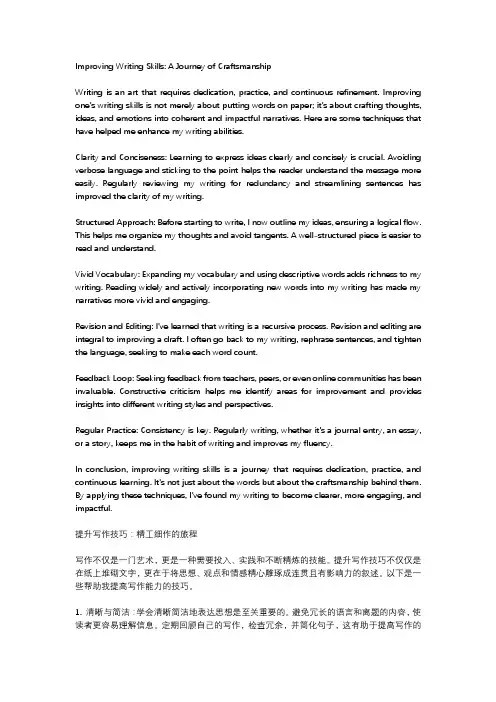
Improving Writing Skills: A Journey of CraftsmanshipWriting is an art that requires dedication, practice, and continuous refinement. Improving one's writing skills is not merely about putting words on paper; it's about crafting thoughts, ideas, and emotions into coherent and impactful narratives. Here are some techniques that have helped me enhance my writing abilities.Clarity and Conciseness: Learning to express ideas clearly and concisely is crucial. Avoiding verbose language and sticking to the point helps the reader understand the message more easily. Regularly reviewing my writing for redundancy and streamlining sentences has improved the clarity of my writing.Structured Approach: Before starting to write, I now outline my ideas, ensuring a logical flow. This helps me organize my thoughts and avoid tangents. A well-structured piece is easier to read and understand.Vivid Vocabulary: Expanding my vocabulary and using descriptive words adds richness to my writing. Reading widely and actively incorporating new words into my writing has made my narratives more vivid and engaging.Revision and Editing: I've learned that writing is a recursive process. Revision and editing are integral to improving a draft. I often go back to my writing, rephrase sentences, and tighten the language, seeking to make each word count.Feedback Loop: Seeking feedback from teachers, peers, or even online communities has been invaluable. Constructive criticism helps me identify areas for improvement and provides insights into different writing styles and perspectives.Regular Practice: Consistency is key. Regularly writing, whether it's a journal entry, an essay, or a story, keeps me in the habit of writing and improves my fluency.In conclusion, improving writing skills is a journey that requires dedication, practice, and continuous learning. It's not just about the words but about the craftsmanship behind them. By applying these techniques, I've found my writing to become clearer, more engaging, and impactful.提升写作技巧:精工细作的旅程写作不仅是一门艺术,更是一种需要投入、实践和不断精炼的技能。
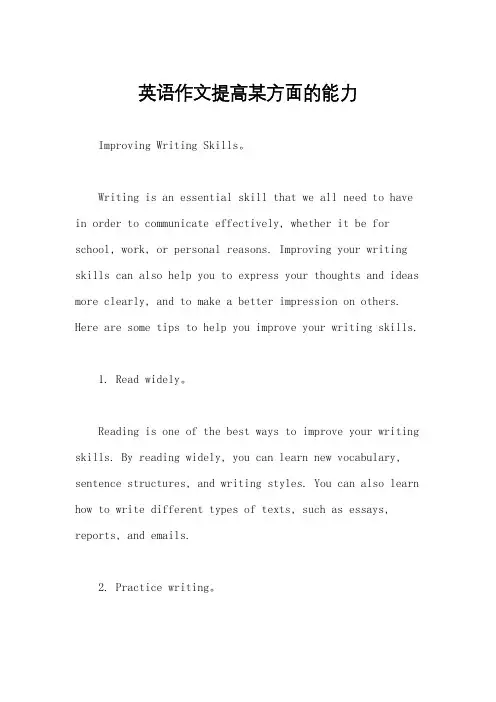
英语作文提高某方面的能力Improving Writing Skills。
Writing is an essential skill that we all need to have in order to communicate effectively, whether it be for school, work, or personal reasons. Improving your writing skills can also help you to express your thoughts and ideas more clearly, and to make a better impression on others. Here are some tips to help you improve your writing skills.1. Read widely。
Reading is one of the best ways to improve your writing skills. By reading widely, you can learn new vocabulary, sentence structures, and writing styles. You can also learn how to write different types of texts, such as essays, reports, and emails.2. Practice writing。
The more you practice writing, the better you will become. Set aside some time each day to write, even if it's just for a few minutes. You can start by writing short paragraphs or journal entries, and then work your way up to longer pieces of writing.3. Get feedback。
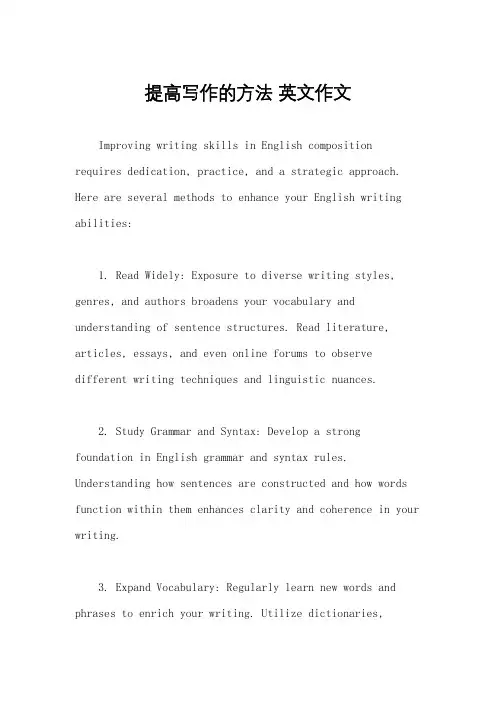
提高写作的方法英文作文Improving writing skills in English composition requires dedication, practice, and a strategic approach. Here are several methods to enhance your English writing abilities:1. Read Widely: Exposure to diverse writing styles, genres, and authors broadens your vocabulary and understanding of sentence structures. Read literature, articles, essays, and even online forums to observe different writing techniques and linguistic nuances.2. Study Grammar and Syntax: Develop a strong foundation in English grammar and syntax rules. Understanding how sentences are constructed and how words function within them enhances clarity and coherence in your writing.3. Expand Vocabulary: Regularly learn new words and phrases to enrich your writing. Utilize dictionaries,thesauruses, and vocabulary-building apps. Experiment with synonyms and antonyms to avoid repetition and add depth to your writing.4. Practice Writing Regularly: Like any skill, writing improves with consistent practice. Set aside dedicated time each day to write. Start with short exercises and gradually work your way up to longer pieces. Focus on different aspects of writing, such as descriptive passages, dialogue, or argumentative essays.5. Receive Feedback: Seek constructive criticism from peers, mentors, or online writing communities. Feedback helps identify areas for improvement and provides valuable insights into your writing style, structure, and clarity.6. Revise and Edit: Writing is a process that involves multiple drafts. After completing a piece, take time to revise and edit it for clarity, coherence, and correctness. Pay attention to organization, transitions, and sentence variety.7. Immerse Yourself in English: Surround yourself with the English language as much as possible. Watch movies, listen to music, and engage in conversations in English. This immersive experience reinforces language skills and improves fluency.8. Set Clear Goals: Define specific writing goals and objectives to track your progress. Whether it's mastering a particular writing style or completing a certain number of words per day, setting targets keeps you motivated and focused.9. Learn from Mistakes: Embrace errors as opportunities for growth. Analyze common mistakes in your writing and take steps to correct them. Keep a journal of recurring errors to track patterns and monitor improvement over time.10. Experiment with Different Styles: Explore various writing styles, such as narrative, expository, persuasive, and creative writing. Each style presents unique challenges and opportunities for expression, allowing you to expand your repertoire as a writer.11. Stay Curious and Open-Minded: Cultivate a curious mindset and remain open to new ideas and perspectives. Curiosity fuels creativity and inspires innovative approaches to writing.By incorporating these methods into your writing routine and staying committed to continuous improvement, you'll gradually enhance your English composition skills and become a more confident and proficient writer.。
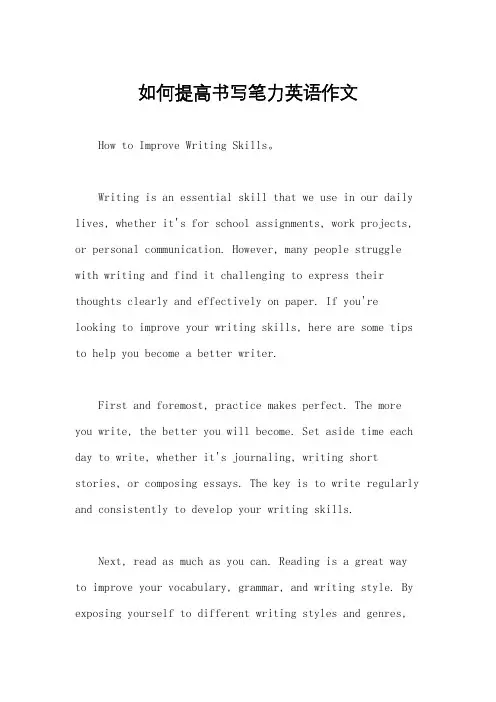
如何提高书写笔力英语作文How to Improve Writing Skills。
Writing is an essential skill that we use in our daily lives, whether it's for school assignments, work projects, or personal communication. However, many people struggle with writing and find it challenging to express their thoughts clearly and effectively on paper. If you're looking to improve your writing skills, here are some tips to help you become a better writer.First and foremost, practice makes perfect. The more you write, the better you will become. Set aside time each day to write, whether it's journaling, writing short stories, or composing essays. The key is to write regularly and consistently to develop your writing skills.Next, read as much as you can. Reading is a great way to improve your vocabulary, grammar, and writing style. By exposing yourself to different writing styles and genres,you can learn new techniques and strategies that you can incorporate into your own writing.Additionally, seek feedback from others. Share your writing with friends, family, or teachers and ask for their input. Constructive criticism can help you identify areas for improvement and provide you with valuable insights on how to enhance your writing.Furthermore, pay attention to grammar and punctuation. Good writing is not just about having great ideas; it's also about presenting those ideas in a clear and coherent manner. Make sure to proofread your work carefully and correct any errors in grammar, punctuation, and spelling.Moreover, expand your vocabulary. A rich vocabulary can make your writing more engaging and impactful. Make an effort to learn new words and phrases, and practice using them in your writing to enhance your language skills.In conclusion, improving your writing skills takes time and effort, but with dedication and practice, you canbecome a more confident and effective writer. Remember to write regularly, read widely, seek feedback, pay attention to grammar, and expand your vocabulary to enhance your writing abilities. By following these tips, you can take your writing to the next level and communicate more effectively through the written word.。
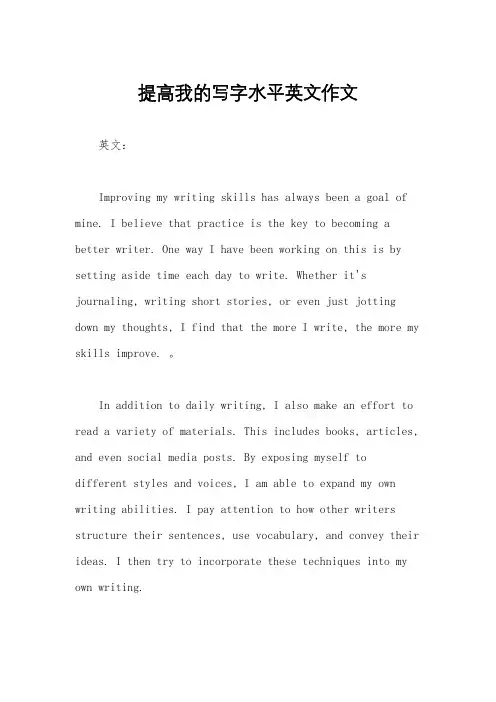
提高我的写字水平英文作文英文:Improving my writing skills has always been a goal of mine. I believe that practice is the key to becoming a better writer. One way I have been working on this is by setting aside time each day to write. Whether it's journaling, writing short stories, or even just jotting down my thoughts, I find that the more I write, the more my skills improve. 。
In addition to daily writing, I also make an effort to read a variety of materials. This includes books, articles, and even social media posts. By exposing myself todifferent styles and voices, I am able to expand my own writing abilities. I pay attention to how other writers structure their sentences, use vocabulary, and convey their ideas. I then try to incorporate these techniques into my own writing.Another strategy I have found helpful is to seek feedback from others. I have joined writing groups and workshops where I can share my work and receive constructive criticism. This has been invaluable in helping me identify areas for improvement and learn from others' perspectives. 。
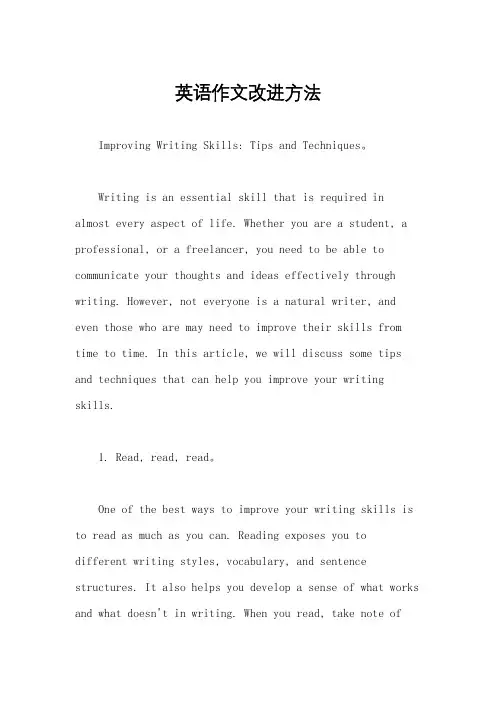
英语作文改进方法Improving Writing Skills: Tips and Techniques。
Writing is an essential skill that is required in almost every aspect of life. Whether you are a student, a professional, or a freelancer, you need to be able to communicate your thoughts and ideas effectively through writing. However, not everyone is a natural writer, and even those who are may need to improve their skills from time to time. In this article, we will discuss some tips and techniques that can help you improve your writing skills.1. Read, read, read。
One of the best ways to improve your writing skills is to read as much as you can. Reading exposes you todifferent writing styles, vocabulary, and sentence structures. It also helps you develop a sense of what works and what doesn't in writing. When you read, take note ofthe author's style and try to identify what makes their writing effective.2. Practice, practice, practice。
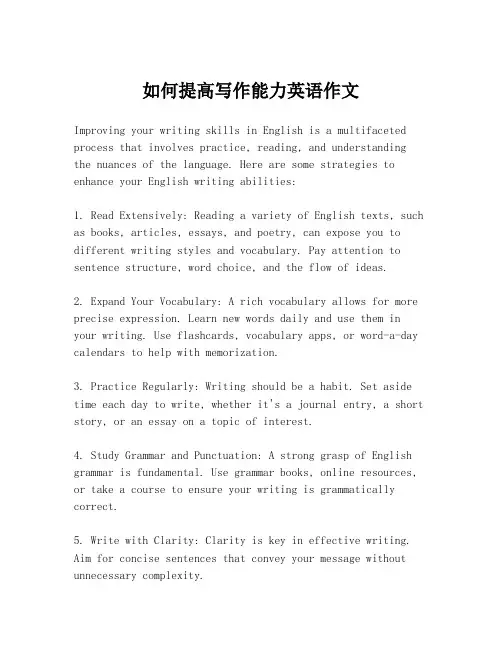
如何提高写作能力英语作文Improving your writing skills in English is a multifaceted process that involves practice, reading, and understanding the nuances of the language. Here are some strategies to enhance your English writing abilities:1. Read Extensively: Reading a variety of English texts, such as books, articles, essays, and poetry, can expose you to different writing styles and vocabulary. Pay attention to sentence structure, word choice, and the flow of ideas.2. Expand Your Vocabulary: A rich vocabulary allows for more precise expression. Learn new words daily and use them in your writing. Use flashcards, vocabulary apps, or word-a-day calendars to help with memorization.3. Practice Regularly: Writing should be a habit. Set aside time each day to write, whether it's a journal entry, a short story, or an essay on a topic of interest.4. Study Grammar and Punctuation: A strong grasp of English grammar is fundamental. Use grammar books, online resources, or take a course to ensure your writing is grammatically correct.5. Write with Clarity: Clarity is key in effective writing. Aim for concise sentences that convey your message without unnecessary complexity.6. Revise and Edit: First drafts are rarely perfect. Review your work critically, looking for areas to improve clarity, remove redundancy, and correct errors.7. Seek Feedback: Share your writing with others and ask for constructive criticism. Feedback can provide valuable insights into areas for improvement.8. Imitate Writers You Admire: Analyze the work of writers you enjoy and try to understand what makes their writing compelling. Practice writing in a similar style, but always strive for originality.9. Use Writing Prompts: Writing prompts can help you think creatively and push your boundaries. They can also be a fun way to practice writing on different topics.10. Learn from Mistakes: Don't be discouraged by errors. Instead, learn from them. Keep a record of common mistakes and review them regularly to avoid repetition.11. Experiment with Different Genres: Trying your hand at different types of writing, such as persuasive essays, descriptive narratives, or analytical reviews, can help you become a more versatile writer.12. Set Goals: Set specific, achievable goals for your writing. It could be a word count for each session, a number of pieces to complete each week, or a target to submit your work for publication.13. Use Technology: Take advantage of writing software and online tools that can help with grammar checks, thesaurus functions, and readability scores.14. Join a Writing Group: Writing groups provide a supportive environment where you can share your work, receive feedback, and learn from other writers.15. Stay Motivated: Writing can be a solitary endeavor. Keep yourself motivated by setting personal challenges, celebrating small victories, and reminding yourself of why you want to improve your writing skills.Remember, improving writing skills is a journey that requires patience and persistence. Keep writing, keep learning, and you will see progress over time.。
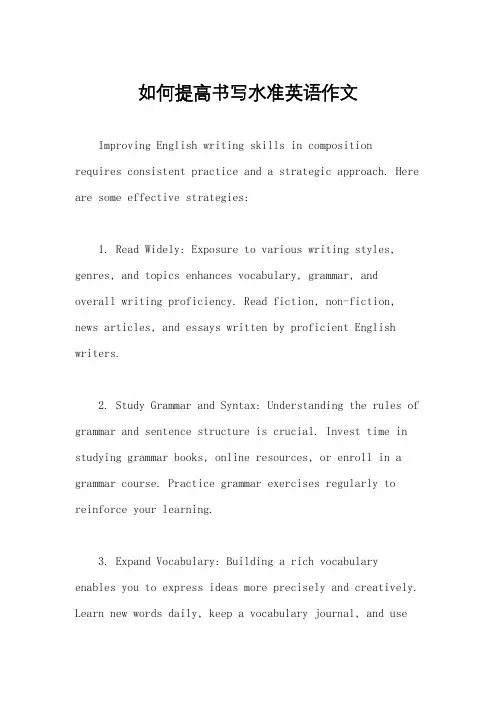
如何提高书写水准英语作文Improving English writing skills in composition requires consistent practice and a strategic approach. Here are some effective strategies:1. Read Widely: Exposure to various writing styles, genres, and topics enhances vocabulary, grammar, andoverall writing proficiency. Read fiction, non-fiction, news articles, and essays written by proficient English writers.2. Study Grammar and Syntax: Understanding the rules of grammar and sentence structure is crucial. Invest time in studying grammar books, online resources, or enroll in a grammar course. Practice grammar exercises regularly to reinforce your learning.3. Expand Vocabulary: Building a rich vocabulary enables you to express ideas more precisely and creatively. Learn new words daily, keep a vocabulary journal, and useonline resources like dictionaries and thesauruses to explore synonyms and antonyms.4. Practice Writing Regularly: Writing consistently is key to improvement. Set aside time each day to write essays, journal entries, or even short stories. Experiment with different writing styles and formats to broaden your skills.5. Seek Feedback: Solicit feedback from peers, teachers, or online writing communities. Constructive criticism helps identify areas for improvement and provides valuableinsights into your writing strengths and weaknesses.6. Edit and Revise: Effective writing involves thorough editing and revision. After completing a draft, take abreak and then revisit it with a critical eye. Look forways to refine your language, clarify ideas, and eliminate errors.7. Imitate Successful Writers: Analyze writing samples from proficient writers and emulate their style, structure, and techniques. Pay attention to how they organize theirideas, use transitions, and employ rhetorical devices.8. Practice Writing Prompts: Engage in timed writing exercises using prompts on various topics. This helps improve your ability to generate ideas quickly, organize thoughts logically, and write cohesively under pressure.9. Utilize Online Resources: Take advantage of online writing tools and resources to enhance your skills. Websites offering writing tips, grammar checkers, and writing communities can provide valuable support and guidance.10. Stay Persistent and Patient: Improving writing skills is a gradual process that requires dedication and perseverance. Stay committed to your writing goals, celebrate progress, and remain patient with yourself as you continue to develop your craft.By incorporating these strategies into your practice routine and maintaining a positive attitude towards learning, you can steadily enhance your English writingproficiency over time. Remember that consistent effort and a willingness to learn are key to achieving your goals.。
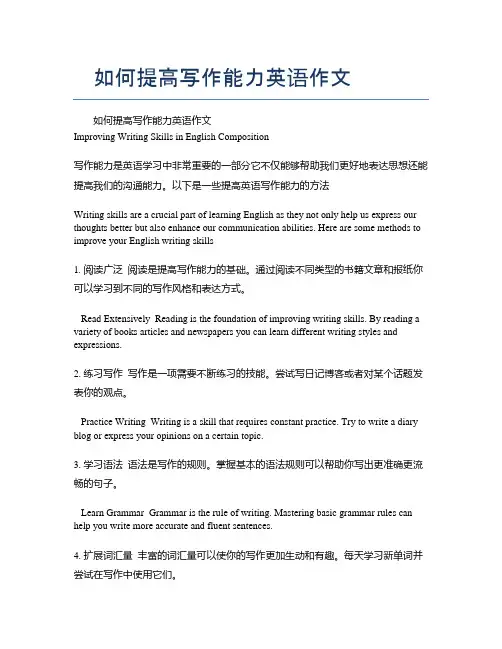
如何提高写作能力英语作文如何提高写作能力英语作文Improving Writing Skills in English Composition写作能力是英语学习中非常重要的一部分它不仅能够帮助我们更好地表达思想还能提高我们的沟通能力。
以下是一些提高英语写作能力的方法Writing skills are a crucial part of learning English as they not only help us express our thoughts better but also enhance our communication abilities. Here are some methods to improve your English writing skills1. 阅读广泛阅读是提高写作能力的基础。
通过阅读不同类型的书籍文章和报纸你可以学习到不同的写作风格和表达方式。
Read Extensively Reading is the foundation of improving writing skills. By reading a variety of books articles and newspapers you can learn different writing styles and expressions.2. 练习写作写作是一项需要不断练习的技能。
尝试写日记博客或者对某个话题发表你的观点。
Practice Writing Writing is a skill that requires constant practice. Try to write a diary blog or express your opinions on a certain topic.3. 学习语法语法是写作的规则。
掌握基本的语法规则可以帮助你写出更准确更流畅的句子。
Learn Grammar Grammar is the rule of writing. Mastering basic grammar rules can help you write more accurate and fluent sentences.4. 扩展词汇量丰富的词汇量可以使你的写作更加生动和有趣。
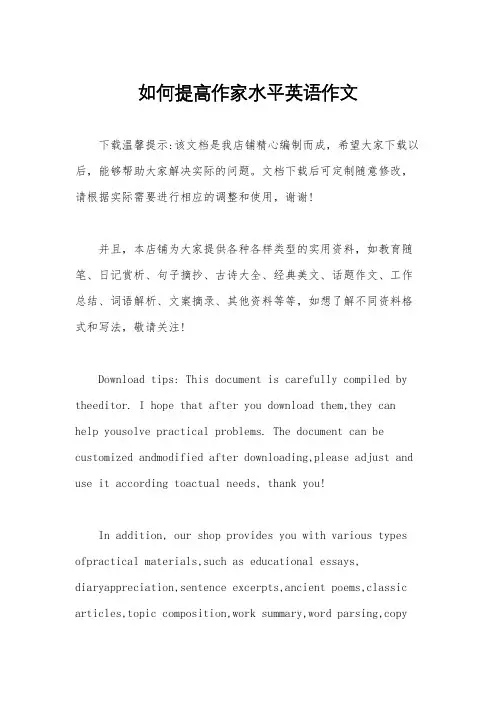
如何提高作家水平英语作文下载温馨提示:该文档是我店铺精心编制而成,希望大家下载以后,能够帮助大家解决实际的问题。
文档下载后可定制随意修改,请根据实际需要进行相应的调整和使用,谢谢!并且,本店铺为大家提供各种各样类型的实用资料,如教育随笔、日记赏析、句子摘抄、古诗大全、经典美文、话题作文、工作总结、词语解析、文案摘录、其他资料等等,如想了解不同资料格式和写法,敬请关注!Download tips: This document is carefully compiled by theeditor. I hope that after you download them,they can help yousolve practical problems. The document can be customized andmodified after downloading,please adjust and use it according toactual needs, thank you!In addition, our shop provides you with various types ofpractical materials,such as educational essays, diaryappreciation,sentence excerpts,ancient poems,classic articles,topic composition,work summary,word parsing,copyexcerpts,other materials and so on,want to know different data formats andwriting methods,please pay attention!As a writer, it is always important to strive for improvement in order to produce better works. Here are some tips on how to improve your writing skills:1. Read extensively: Reading is one of the best ways to improve your writing skills. It exposes you to different writing styles, genres and helps you to expand your vocabulary. Make it a habit to read widely, and take noteof the writing techniques used by different authors.2. Practice writing regularly: Writing is a skill that requires practice. Set aside time each day to write, evenif it's just for a few minutes. You can start by writing about your daily experiences or observations. The more you write, the better you become.3. Get feedback: Feedback is essential for growth.Share your work with others and ask for feedback. This can be from friends, family, or even online writing communities.Take constructive criticism positively and use it to improve your writing.4. Learn grammar and punctuation: Good writing requires proper grammar and punctuation. Take the time to learn the rules of grammar and punctuation. There are many online resources and books available to help you with this.5. Edit your work: Editing is an important part of the writing process. After you have written your piece, take the time to edit it. Look for errors in grammar, punctuation, and spelling. Also, check for clarity and coherence.6. Experiment with different writing styles: Don't be afraid to try out different writing styles. Experiment with different genres, tones, and perspectives. This will help you to find your unique writing voice.7. Write with passion: Finally, write with passion. Write about things that you are passionate about. This will help you to connect with your readers and make your writingmore engaging.In conclusion, improving your writing skills requires practice, feedback, and a willingness to learn. Keep these tips in mind and you will be on your way to becoming a better writer.。
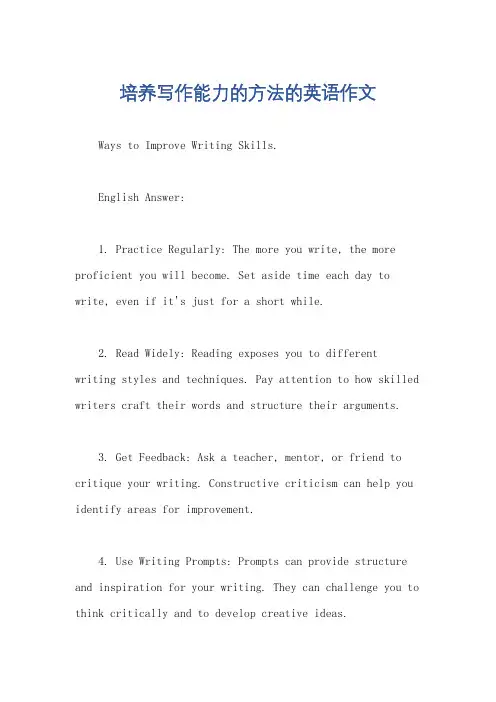
培养写作能力的方法的英语作文Ways to Improve Writing Skills.English Answer:1. Practice Regularly: The more you write, the more proficient you will become. Set aside time each day to write, even if it's just for a short while.2. Read Widely: Reading exposes you to differentwriting styles and techniques. Pay attention to how skilled writers craft their words and structure their arguments.3. Get Feedback: Ask a teacher, mentor, or friend to critique your writing. Constructive criticism can help you identify areas for improvement.4. Use Writing Prompts: Prompts can provide structure and inspiration for your writing. They can challenge you to think critically and to develop creative ideas.5. Experiment with Different Forms: Try your hand at different types of writing, such as essays, articles, short stories, and poems. Each form has its own unique set of challenges and rewards.6. Use Technology: Grammar and spelling checkers can help you polish your writing. Word processors and online writing tools can streamline the writing process.7. Join a Writing Workshop: Engage with other writersto share ideas, get feedback, and learn from each other. Workshops can provide a supportive and collaborative environment for writing growth.8. Attend Writing Conferences: Conferences offer opportunities to meet established authors, attend workshops, and network with other aspiring writers.9. Study the Craft: Read books and articles about writing. Learn about different writing techniques, styles, and genres. The more you know, the more effectively you canapply it to your own writing.10. Be Patient and Persistent: Writing is a skill that takes time and effort to develop. Don't get discouraged if you don't see immediate results. Keep practicing, learning, and improving.中文回答:1. 坚持练习,写作越频繁,你的熟练度就会越高。
怎样提高作文写作能力英语How to Improve Writing Skills in English。
Writing is an essential skill in our daily lives, especially when it comes to academic and professional settings. Therefore, it is crucial to continuously work on improving our writing skills in English. Here are some tips on how to enhance your writing abilities:1. Read regularly: Reading is the foundation of good writing. By reading a variety of materials such as books, articles, and essays, you can expose yourself to different writing styles, vocabulary, and sentence structures. This will help you expand your knowledge and improve your own writing skills.2. Practice writing every day: Like any other skill, writing requires practice to improve. Set aside some time each day to write, whether it's journaling, blogging, or working on essays. The more you practice, the better youwill become at expressing your thoughts and ideas on paper.3. Expand your vocabulary: A rich vocabulary is essential for effective writing. Make an effort to learn new words and phrases every day and incorporate them into your writing. This will not only make your writing more interesting but also help you convey your ideas more clearly.4. Seek feedback: Feedback is crucial for growth. Share your writing with friends, family, or teachers and ask for their opinions. Constructive criticism can help youidentify areas for improvement and make necessary changes to enhance your writing skills.5. Study grammar and punctuation: Good writing requiresa solid understanding of grammar and punctuation rules. Take the time to review these rules and practice applying them in your writing. This will help you avoid common mistakes and make your writing more polished and professional.6. Edit and revise: Writing is a process, and it's rare to produce a perfect piece on the first try. Take the time to edit and revise your work, paying attention to clarity, coherence, and organization. This will help you refine your writing and produce a more polished final product.In conclusion, improving your writing skills in English takes time and effort, but the rewards are well worth it. By reading regularly, practicing writing daily, expanding your vocabulary, seeking feedback, studying grammar and punctuation, and editing and revising your work, you can enhance your writing abilities and become a more effective communicator. Remember, writing is a skill that can always be improved, so don't be afraid to challenge yourself and strive for excellence in your writing.。
提升我的英语成绩英文作文Improving English Writing Skills。
Improving one's English writing skills requires dedication, practice, and a systematic approach. Here are some strategies and tips that can help you enhance your English writing abilities:1. Read Extensively: Reading extensively exposes you to various writing styles, vocabulary, and sentence structures. Read a wide range of materials such as books, newspapers, magazines, and online articles. Pay attention to howauthors express their ideas and how they structure their sentences and paragraphs.2. Expand Vocabulary: Building a strong vocabulary is essential for effective writing. Make a habit of learning new words regularly. Use tools like vocabulary flashcards, word games, and vocabulary-building apps. Additionally, try to use newly learned words in your writing to reinforcethem.3. Practice Writing Regularly: Like any other skill, writing improves with practice. Set aside time each day for writing exercises. Start with simple tasks like journaling or writing short paragraphs about your day. As you become more comfortable, challenge yourself with more complex writing tasks such as essays or argumentative pieces.4. Seek Feedback: Feedback is crucial for improvement. Share your writing with teachers, peers, or online communities for constructive criticism. Pay attention to their suggestions and use them to refine your writing skills. Don't be afraid to make mistakes; learning from them is part of the process.5. Study Grammar and Sentence Structure: A solid understanding of grammar rules and sentence structure is fundamental to good writing. Review grammar guides and practice grammar exercises regularly. Pay attention to sentence variety, avoiding repetitive structures, and maintaining coherence and clarity in your writing.6. Imitate Good Writers: Study the works of accomplished writers and try to emulate their style. Analyze how they structure their sentences, develop their arguments, and use language creatively. While imitating, strive to maintain your own voice and authenticity.7. Edit and Revise: Writing is a process that involves multiple drafts. After completing a piece of writing, take time to revise and edit it. Look for ways to improve clarity, coherence, and organization. Check for grammatical errors, punctuation mistakes, and typos. Consider seeking assistance from writing guides or online writing tools.8. Set Goals: Set specific and achievable writing goals to track your progress. Whether it's writing a certain number of words per day, completing an essay by a deadline, or mastering a particular writing skill, having clear goals will keep you motivated and focused on improvement.9. Stay Consistent: Consistency is key to improvement. Make writing a regular part of your routine, even when youdon't feel inspired. Over time, consistent practice will lead to significant progress in your English writing skills.10. Use Resources: Take advantage of availableresources to support your learning journey. Utilize writing guides, online courses, writing workshops, and language exchange programs to enhance your writing skills further.By incorporating these strategies into your dailyroutine and maintaining a positive attitude towards learning, you can make significant strides in improvingyour English writing skills. Remember that improvementtakes time and patience, so stay committed to your goalsand keep practicing consistently.。
提高我的写字水平英文作文Improving one's writing skills is a commendable endeavor. Here are some tips to enhance your English composition:1. Read Widely: Exposure to diverse writing styles, genres, and authors can broaden your vocabulary and understanding of sentence structures. Read books, articles, essays, and even online forums to immerse yourself in English language usage.2. Practice Regularly: Writing regularly is essential for improvement. Set aside time each day to write, whether it's journaling, creative writing, or academic essays. Consistent practice helps solidify language skills and fosters creativity.3. Seek Feedback: Constructive criticism is invaluable for growth. Share your writing with peers, teachers, or online writing communities to receive feedback on areas forimprovement. Pay attention to common errors or weak points pointed out by others.4. Focus on Grammar and Syntax: Grammar and syntax form the foundation of effective writing. Review English grammar rules and practice applying them in your writing. Pay attention to sentence structure, punctuation, and tense consistency.5. Expand Vocabulary: A rich vocabulary enhances your ability to express ideas accurately and vividly. Learn new words regularly and strive to incorporate them into your writing. Experiment with synonyms and varied language to avoid repetition.6. Study Writing Techniques: Analyze well-written pieces to understand what makes them effective. Pay attention to the organization, coherence, and clarity of the writing. Learn techniques such as storytelling, persuasion, and argumentation to enhance your own writing skills.7. Edit and Revise: Writing is a process that involves multiple drafts and revisions. After completing a draft, take time to review and revise it for clarity, coherence, and style. Look for opportunities to improve sentence structure, eliminate unnecessary words, and refine your message.8. Immerse Yourself in English: Surround yourself with the English language as much as possible. Watch English movies and TV shows, listen to English podcasts or music, and engage in conversations with native speakers. The more you expose yourself to English, the more natural your writing will become.9. Set Goals and Track Progress: Establish specific writing goals and track your progress over time. Whetherit's writing a certain number of words per day or mastering a particular writing skill, setting goals providesdirection and motivation for improvement.10. Stay Motivated and Persistent: Improving writing skills takes time and effort, so stay motivated andpersistent in your practice. Celebrate small victories along the way and remember that every writing session is an opportunity to grow.By incorporating these strategies into your writing routine, you can gradually enhance your English composition skills and become a more confident and proficient writer. Keep practicing, seeking feedback, and pushing yourself to improve, and you'll see progress over time.。
如何提高作家水平英语作文标题,How to Improve Writing Skills: A Comprehensive Guide for Writers。
Writing is a craft that requires continuous honing and refinement. Whether you're a novice writer or an experienced wordsmith, there's always room for improvement. In this essay, we'll delve into various strategies and techniques that can elevate your writing to new heights.1. Read Widely and Analytically: One of the most effective ways to improve your writing is by reading extensively. Explore different genres, styles, and authors to broaden your perspective. Analyze how successful writers construct their sentences, develop characters, and build plots. Pay attention to language use, sentence structure, and narrative techniques.2. Write Regularly: Like any skill, writing improves with practice. Set aside dedicated time each day to write,whether it's journaling, creative writing, or essays. Challenge yourself with writing prompts and exercises to stimulate your creativity and expand your repertoire.3. Seek Feedback: Constructive feedback is invaluable for growth as a writer. Join writing groups, workshops, or online communities where you can share your work and receive critiques from peers. Be open to criticism and use it as a learning opportunity to identify areas for improvement.4. Study Grammar and Style: A solid grasp of grammar and style enhances clarity and coherence in your writing. Brush up on grammar rules, punctuation, and syntax. Experiment with different writing styles and techniques to find your voice and develop your unique writing style.5. Expand Your Vocabulary: A rich vocabulary adds depth and precision to your writing. Make a habit of learning new words and phrases, and incorporate them into your writing. Use a thesaurus to find synonyms and explore alternative ways to express ideas.6. Edit and Revise: Writing is rewriting. Don't be afraid to revise your work multiple times to refine your ideas and polish your prose. Focus on tightening your sentences, eliminating redundancies, and improving clarity and coherence. Consider the overall structure and flow of your writing to ensure it resonates with your readers.7. Study Craft Books and Resources: Take advantage of the wealth of resources available on writing craft. Read books on storytelling, character development, plot structure, and narrative techniques. Attend writing workshops, seminars, or online courses to deepen your understanding of the craft.8. Immerse Yourself in Writing: Surround yourself with writing-related activities and experiences. Attend literary events, book readings, and author interviews. Engage with other forms of storytelling, such as films, plays, and podcasts, to gain new insights and perspectives.9. Practice Empathy and Observation: Writing is a meansof connecting with readers on an emotional level. Cultivate empathy and observation skills to better understand human nature and behavior. Draw inspiration from real-life experiences, emotions, and relationships to infuse authenticity and depth into your writing.10. Stay Persistent and Patient: Rome wasn't built in a day, and neither is mastery of the written word. Stay committed to your writing journey, even in the face of setbacks and challenges. Celebrate your progress and milestones along the way, and remember that every word written is a step closer to achieving your goals as a writer.In conclusion, improving as a writer is a lifelong journey of learning, experimentation, and growth. By incorporating these strategies into your writing routine and embracing the process of continuous improvement, you can elevate your writing to new levels of excellence. Keep writing, keep learning, and keep striving for greatness.。
加强英文作文写作能力英文:Improving English writing skills is a challenge that many people face. However, with practice and dedication, it is possible to enhance your writing abilities. Here are some tips that can help:1. Read extensively: Reading is an excellent way to improve your writing skills. It exposes you to different writing styles, vocabulary, and grammar structures. When you read, pay attention to the writer's use of language and try to incorporate it into your own writing.2. Write regularly: Practice is essential when it comes to writing. Set aside some time each day to write, even if it's just a few sentences. This will help you develop a writing habit and improve your skills over time.3. Get feedback: It's important to get feedback on yourwriting from others. This can be from a teacher, friend, or writing group. They can provide you with constructive criticism and help you identify areas for improvement.4. Use online resources: There are many online resources available that can help you improve your writing skills. These include grammar and vocabulary websites, writing prompts, and online courses.5. Be patient: Improving your writing skills takes time and effort. Don't expect to see results overnight. Be patient, keep practicing, and you will see improvement.中文:提高英文写作能力是许多人面临的挑战。
提高写作能力英语作文Improving Writing Skills。
Writing is an essential skill that every person should possess. It is a form of communication that allows us to express our thoughts and ideas to others. However, writing can be a challenging task for many people, especially those who are not native speakers of the language. Therefore, it is important to develop and improve our writing skills to become effective communicators.The following are some tips on how to improve your writing skills:1. Read extensively。
Reading is one of the best ways to improve your writing skills. It exposes you to different writing styles, vocabulary, and grammar structures. By reading extensively, you can learn how to write effectively and efficiently.2. Practice writing regularly。
Practice makes perfect. The more you write, the better you become. Set aside some time every day to write, whether it's a journal entry, a blog post, or a short story. The more you practice, the more comfortable you will become with the writing process.3. Use online resources。
Improving Writing Skills: ELLs and the Joy of WritingBy Kristina Robertson"The meaning of even a single word is rather more complex thanone might imagine."- Editors of the American Heritage Dictionary, 1980, p. viii "Teacher, do we need our pencils today?" my Puerto Rican elementary students would urgently ask when I came to their classroom to escort them to my English as a Second Language classroom.I was a student teacher in a Massachusetts elementary school, and it took me awhile to figure out the correlation between the pencil and hallway behavior. If I replied, "Yes, you should bring a pencil," the walk to my classroom took 15 minutes and involved a lot of disruptions, student squabbles, drifting students and other various misbehaviors. As a student teacher, I was very focused on keeping order and creating a challenging learning environment. If I replied, "No, you don't need a pencil today," the walk to my classroom took about five minutes, even with a stop at the drinking fountain.So, what was the correlation? Writing. The students knew that if they had to bring a pencil they would have to do writing in the class, and they dreaded it. If they didn't need a pencil, we would be working on projects or doing more verbal work, and they liked that. What they weren't expecting was that half-way through my student teaching, I bought 10 boxes of pencils and kept them in my classroom, so they never had to bring a pencil to class — I had plenty to go around. This improved the hallway behavior, but still left me with the question of how to improve ESL student writing when they were frustrated by the practice and went to great lengths to avoid it.I have been teaching ESL for many years and there is no perfect solution to this problem; however, I do believe I have added quite a few writing activities to my bag of tricks and improved my ability to differentiate writing tasks based on student ability. As I improved my ability to ensure that each student would be successful in the writing activity, t heir confidence increased, and they were less likely to engage in disruptive behavior. You know what I'm talking about — the long, dramatic search for a pencil and then paper or the meandering walk about the room to get yesterday's writing draft, or the ever popular, "15 minute pencil sharpening" session. I hope some of the writing activities I share with you will help you to reduce anxiety in your ESL students and increase their language and writing skills.There is a very important correlation between writing and language development. As students develop language skills, they often develop listening skills first (lots of input they can understand), then speaking (they begin to formulate their ideas in the second language), then reading (they can understand the sound/symbol correspondence of the new language and make sense of the words) and finally writing (they have enough language to express their own ideas in writing). This is not true for 100% of language learners, but it is true for the majority of them. Why is writing often the last skill to emerge?It almost seems that reading would be more difficult because the student needs to sound out words and understand the author's message. It would seem writing might be easier because students are sharing their own ideas already in their heads and simply putting them on paper. However, writing requires a lot more processing of language in order to produce a message.First the student must have an idea, then think of the appropriate way to say it, then start to write it and spell it correctly, and then create another sentence to continue to communicate the idea. If we add the students' worry that they are making huge, embarrassing errors or that their ideas aren't very good in the first place, then we begin to understand the complexity involved in writing in a second language. In fact, the way we communicate, or the way students put their ideas on paper, is largely influenced by their culture. In some of my classes, my Asian students were very confused when I told them to revise their writing because this was a "first draft." In their experience they had always written an item once and submitted it as "the final," and then the teacher would correct it. The idea that they had to write it over again didn't make sense to them. S tudents from other cultures may have developed a storytelling style that involves laying out a lot of background information and detail and takes quite a while to get to the point. In most western writing, we expect a topic sentence or a lead paragraph that will tell us what the point is, and then everything written after that leads to a direct conclusion. Many of my students had great difficulty connecting their ideas this way.With that said, teachers have a big task in improving ESL student writing skills, but the payoff for instructional dedication can be great. A researcher on adolescent literacy at the University of Minnesota, David O'Brien, did a study on improving the reading skills of adolescent students. All of the students were involved in a six week study and during that time they were responsible for creating brochures and other types of communication on computers. They had criteria to input a certain amount of text and graphics to create a final project. This required lots of thought and revisions to achieve the final result. At the end of the six weeks the students took a reading test and the majority of them had improved their reading skills significantly. This was a very interesting result, considering that the teachers had not focused on teaching reading skills. The conclusion was that students used meta-cognition to process language and work with it in a more meaningful way, so that consequently their reading skills improved even though they were mostly working on writing.Additional positive academic results have been seen in the "90 90 90 Schools." These are schools that researchers have identified as 90% poverty, 90% students of color and 90% achieving standards. This is a most remarkable combination in the educational world. The researchers examined these schools and found one common denominator among them — they all focused on developing writing skills. Each school had an agreed upon writing curriculum and methodology that was used at all grade levels, and student writing was prominently displayed throughout the building and in classrooms. Students used writing in all content areas to demonstrate academic concepts learned. In the end, 90% of the students in these schools were able to pass state grade-level tests based on the academic standards.Now that I have hopefully convinced you that all your hard work will pay off, I would like to introduce some effective writing activities. I would like to acknowledge that there are many types of effective writing instruction used in classrooms today, including process writing, graphic organizers as writing planning tools, vocabulary stretchers, etc., and all of those are beneficial to ELL students. For the purpose of this article, I will focus on a few writing activities that I think are particularly useful when working with students with a wide-range of English language skills.How to differentiate writing activities:With some pre-planning, a teacher can create a writing assignment that will allow every student to be successful. For example, the teacher may give a writing assignment that has A, B and C levels (or they can be number or color-coded).∙ELL students at Level A copy a sentence or short passage exactly as it is written. This helps beginning-level students who are not very familiar with the language, but may be able to interpret some of the information as they copy it.∙Level B students receive a paragraph or two that has blank spaces in the text. The students write the word or phrase that completes the sentence. This allows the student to write an amount that is not overwhelming and helps them comprehend the information.∙Level C students write on their own, but perhaps they receive paragraph prompts or are allowed to look in a book, but must put the idea in their own words. After some practice with this system and getting to know your students' English language skills, you will be able to create a system that works best for your class.Language Experience ApproachThe Language Experience Approach draws on instructional techniques used with younger children who have not yet developed literacy skills. In this approach, the teacher presents information to the students, or they have an "experience" of some sort — for example, a field trip, or acting out a scene in a book. Then the students tell the teacher what to write on the board to explain the experience. This may be useful as an activity for a volunteer or teacher's aide to use with a small group of ESL students during literacy time. Here are the steps.1. Experience something — for example, the students have listened to the story, "The Little RedHen" and then acted it out.2. The teacher stands by the board or a large sheet of paper and says to the students, "Tell methe story of the Little Red Hen."3. As each student tells a part of the story, the teacher writes it down on the board, just as it wasstated. For example, a student might say, "The Little Red Hen work so hard and nobody want help her." This continues until each student has spoken or the story is finished.4. Then the teacher tells the students, "Let's read the story together and listen to see if thestory makes sense and if there is anything we want to change."5. After reading the story, the teacher asks students if they want to change anything. For example, one student may raise her hand and say, "I think it should say, "worked" not "work." The teacher may ask other students if they agree or disagree.6. If the suggested change is correct, the teacher offers praise and moves on to the next susuggestion. If the suggested change is not correct, the teacher should help the student analyze the ggested change. For example, if the student says, "I think it should say, “The Little Red Hen she worked so hard." The teacher would ask if others agree and see if there is discussion, then the teacher could point out that the Little Red Hen is the pronoun or "name," so in English we don't need to put it in twice. We can say "She worked so hard." Or "The Little Red Hen worked so hard."7. When students have analyzed and corrected the whole text, the teacher may either circle a few more spots where students missed corrections and they can be challenged to figure out what the change should be, or the students can be instructed to copy the text with the corrections included.8. As a final activity, students are instructed to take the story home and read it to three people and bring it back with signatures.After this activity, usually even beginning-level ELL students are able to read the story to others because it was their experience, it is in their own words, and they have worked with the text in a meaningful way.Sentence AuctionThis activity helps students analyze common writing errors through a personalized activity since they are trying to buy their own sentences. Once a week or once a month, a teacher can hold a "Sentence Auction." The teacher takes sentence examples from student writing — some of which have errors and some that don't, and writes them on a handout or overhead projector. The identity of the student who wrote each sentence is not revealed. To begin the sentence auction, each student is given an "account" of perhaps $300. The students are told to "bid" on the good sentences. The winner is the student with the highest number of "good" sentences.1. The teacher takes on the persona of an "Auctioneer" and opens the bidding at $10.2. The teacher reads out the sentence confidently exactly as it is written. "Him want to go toschool very bad." Who will give me $10?"3. The students take turns bidding until the teacher decides who has "won" the bid.4. Some sentences will not sell because students will know they are "bad." Just leave thosesentences and move to the next one.5. After all the sentences have been sold, the teacher goes through the list and the students saywhether the sentence was good or bad. If they agree that it was a bad sentence, then the teacher asks them to explain how they can make it a "good" sentence.6. Finally the students can count how many "good" sentences they have (since they may havebought some bad ones) and a winner is declared.7. The teacher may want to give a little prize or certificate to the student. In a variation of thisactivity students can work in pairs or groups to buy the sentences.Error correctionI have never "corrected" my students' writing mistakes, at least not in the traditional way. I have always told my students, "If I correct your English, I improve my English; if you correct your English, you improve yours." I handled corrections in one of two ways: either I identified what errors I would be looking for in the writing submission or I told them I would only circle five errors in the whole paper. If I pre-set the errors I would look for, for example correct use of past tense, I would only correct past tense errors, even if I saw other glaring errors in the paper. Sometimes this was hard to do, but I wanted to maintain the students' focus on the writing improvement we were working on. If I set a number of errors I would circle, for example, five, then I carefully chose those five and ignored the rest. When I returned the papers, the students were responsible for correcting their own mistakes. If they weren't sure how to do it, they could check with a classmate, and if no one knew, then I would assist. Invariably the students would ask, "Are these the only errors in the paper?" and I would tell them no. They might be disappointed, but they came to understand the value of correcting their own errors when they submitted a piece of writing.Quick WriteOne of the challenges for ELL students when they approach writing is their anxiety about writing their ideas correctly and writing a lot of information in English. This may feel overwhelming when a student is assigned an essay. In order to get students comfortable with the idea of just putting ideas on paper and not worrying about mistakes, we do regular "quick writes." For "quick writes" I give the students a topic and then tell them to write as much as they can for five minutes. They need to keep their pencils on the paper and even if they can't think of anything to write or they are worried about how to spell things, they are supposed to keep writing. At the end of five minutes, the students count how many words they were able to write and they keep track in a log. The objective is that they will see progress in the amount of writing they are able to do in five minutes' time and hopefully apply this fluency to their essay writing.Cinquain poemsCinquain poems offer great flexibility in working with ELL students of a variety of language levels. The basic Cinquain formula is as follows, but teachers can modify it as needed according to the student language level.One nounTwo adjectivesThree gerunds (words + ing)A short sentence.A one-word summaryAn example of a Cinquain a student might write:HomeWarm, happyLoving, welcoming, helpingPeople you love.FamilyThere really is no wrong way to do a Cinquain, students can put key vocabulary words together any way they like to create the message they desire. Teachers may want to use Cinquains to reinforce new content vocabulary and concepts as well.With these writing activities to try in your classroom, the only thing left is to buy a few boxes of pencils, hand them out to your ELL students and help them discover the possibility of joy in writing. Teachers who use a variety of activities and strategies to help ELL students become comfortable with expressing their ideas in a new language and finding success with small writing tasks, will give their students' confidence for a lifetime of self-expression. I offer this Cinquain poem to sum it up.WritingFun, creativeThinking, sharing, revisingLots of ideas.Proud。